
Chromodorididae, or chromodorids, are a taxonomic family of colourful sea slugs; dorid nudibranchs, marine gastropod mollusks in the superfamily Doridoidea. “Chromodorid nudibranchs are among the most gorgeously coloured of all animals.” The over 360 described species are primarily found in tropical and subtropical waters, as members of coral reef communities, specifically associated with their sponge prey. The chromodorids are the most speciose family of opisthobranchs. They range in size from <10mm to over 30 cm, although most species are approximately 15–30 mm in size.
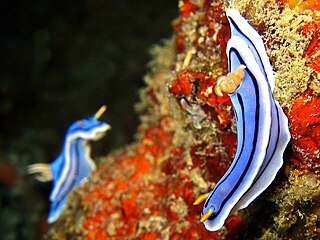
Chromodoris is a genus of very colourful sea slugs or dorid nudibranchs, marine gastropod molluscs, and the type genus of the family Chromodorididae. Within the genus Chromodoris, there are currently 101 classified species. Species within Chromodoris are commonly found in tropical and subtropical waters, living as members of reef communities and preying primarily on sponges. A molecular phylogeny of the family Chromodorididae resulted in this genus being restricted to a smaller number of species than formerly, most of which have longitudinal black lines on the mantle. Many former members of Chromodoris were transferred to Goniobranchus
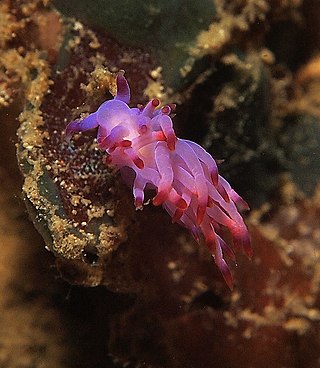
Trinchesia sibogae is a species of sea slug, an aeolid nudibranch, a marine gastropod mollusc in the family Trinchesiidae.

Rudolph Bergh, full name Ludvig Sophus Rudolph Bergh, was a Danish physician and malacologist. He worked in Copenhagen.

Glossodoris is a genus of sea slugs, dorid nudibranchs, shell-less marine gastropod mollusks in the family Chromodorididae.
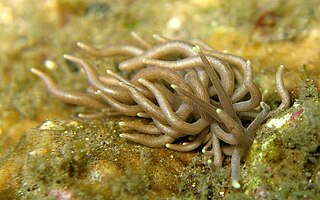
Phyllodesmium is a genus of predatory sea slugs, aeolid nudibranchs, marine gastropod molluscs in the family Myrrhinidae.

Phyllodesmium longicirrum, common name the solar-powered phyllodesmium, is a species of sea slug, an aeolid nudibranch, a marine gastropod mollusc in the family Facelinidae.
Doriprismatica sibogae is a species of sea slug, a dorid nudibranch, a shell-less marine gastropod mollusk in the family Chromodorididae.

Phestilla melanobrachia is a species of sea slug, an aeolid nudibranch, a marine gastropod mollusk in the family Trinchesiidae.
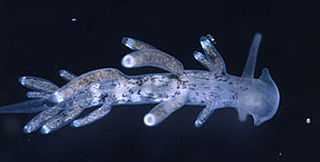
Tenellia is a genus of sea slugs, aeolid nudibranchs, marine gastropod molluscs in the family Trinchesiidae.

Phestilla is a genus of sea slugs, aeolid nudibranchs, marine gastropod molluscs in the family Trinchesiidae.

Doriprismatica is a genus of sea slugs, dorid nudibranchs, shell-less marine gastropod mollusks in the family Chromodorididae.

A corallivore is an animal that feeds on coral. Corallivores are an important group of reef organism because they can influence coral abundance, distribution, and community structure. Corallivores feed on coral using a variety of unique adaptations and strategies. Known corallivores include certain mollusks, annelids, fish, crustaceans, flatworms and echinoderms. The first recorded evidence of corallivory was presented by Charles Darwin in 1842 during his voyage on HMS Beagle in which he found coral in the stomach of two Scarus parrotfish.

Phestilla lugubris is a species of sea slug, an aeolid nudibranch, a marine gastropod mollusk in the family Trinchesiidae.

Phestilla minor is a species of sea slug in the Trichechidae family. It is a type of aeolid nudibranch under the Aeolidina suborder. Phestilla minor is a benthic sea slug that is a very small, slow-moving organism found in marine habitats all over the world.
Phestilla panamica is a species of sea slug, an aeolid nudibranch, a marine gastropod mollusk in the family Trinchesiidae. The species feeds on the hard coral genus Porites.
Phestilla poritophages is a species of sea slug, an aeolid nudibranch, a marine gastropod mollusk in the family Trinchesiidae. The species was named after its prey genus, the hard coral Porites.
Marionia distincta is a species of sea slug, a dendronotid nudibranch, a marine gastropod mollusc in the family Tritoniidae.
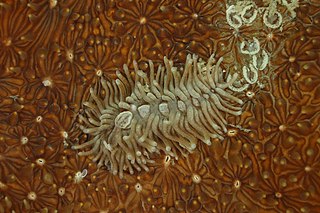
Phestilla viei is a species of coral-feeding sea slug, an aeolid nudibranch, from the family Trinchesiidae, described in 2020. It has been identified as a sister species of Phestilla fuscostriata based on DNA barcoding using the COI gene. The genus Phestilla currently includes nine recognized species, eight of which are obligate corallivores, with each particular species predating on only one species or genus of coral. Its distribution is restricted to the Indo-Pacific Ocean.














